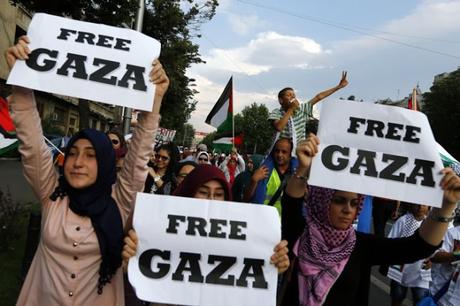 (This photo of Gaza protests, from the International Business Times, is by Bogdan Cristel / Reuters.)
(This photo of Gaza protests, from the International Business Times, is by Bogdan Cristel / Reuters.)The Israeli government and the Trump administration would like for you to believe that the Gaza protests are nothing more than an attempt by Hamas to vilify Israel -- and that Israel is not mistreating the Palestinian people living in Gaza. The truth is far different.
The following article is from Think Progress. It is an explanation by a resident of Gaza (Intimaa Alsdudi) of why the people of Gaza are really demonstrating.
Zaheyya, 70 years old and tired after a long walk from Saladin Road to the “no-go” zone, looked among the huge crowd of protesters for a place to rest as she carried a Palestinian flag and her embroidered bag over her shoulder. When I approached Zaheyya on Monday and asked if I could interview her to find out why she is participating in the Great Return March in spite of her age and sickness, she replied, “Shame on you, for asking me this question! I will come every day until U.N. Resolution 194 is implemented.” The resolution Zaheyya recalled was adopted by the U.N. General Assembly in 1948, and it called for the return of all Palestinian refugees to their lands. It was never adopted by the U.N. Security Council, and so it was never enforced. But Palestinians have not forgotten. “I am a refugee from Huliqat village that was ethnically cleansed in 1948 by the hands of the Haganah [the Zionist paramilitary organization] and I have the right to go back,” said Zaheyya. “This is our day to show Israel that the old will die, but the young will never forget… Yes, I will join my people and shout with all my strength, move on people, go back to your homeland, the land is waiting for you.” It was inspiring, but then Zaheyya started shouting something else. “Tear gas, gas, gas! Run people, run!” Tear gas cans began rolling between us and the crowds. Everyone ran from the area, while Israeli snipers on top of the hills and watchtowers started shooting randomly at the people protesting. At one point, I lost sight of my mom. I could not see her, because there was dark smoke everywhere. Do you know what that feels like? To not know if your mother is okay as snipers are shooting at you and everyone around you? It took me half an hour to find her again — when the air cleared out from the tear gas bombs. After we did, my mom, as always, hugged me. “Calm down. I am okay,” she said. We started laughing and cursing the snipers. Monday was hard, and it was heartbreaking. After a long day, I found out that my brother Mustafa, who is 29 years old, was shot. He was lucky, the bullet that penetrated his leg was not explosive. At least 62 people were killed that day, and nearly 3,200 wounded, according to the Palestinian Health Ministry in Gaza. Those injured included journalists, medics, and dozens of women. Since then, all of the victims have been painted in the international media as martyrs for Hamas. All the protesters – me, my family, Zaheyya, thousands of others like us – have had our demands warped and our voices silenced by others for political purposes. So let me be clear with you. Gaza is the biggest open-air prison on earth. Nearly two million people are denied the basic freedom of movement. Ninety-seven percent of the water here is undrinkable. The unemployment rate is 44 percent We have said over and over again that the right of return is the solution to all of our miserable problems. That is why we protested on Monday. That is why we have been protesting since March 30. Two-thirds of Palestinians in Gaza are refugees from lands stolen by Israel in 1948. The Great Return March is the first time in my life that I have seen a huge number of people uniting and calling for right of return. It is the decision of ordinary Palestinians in Gaza, and it is the call for everyone who is concerned about humanity. There is only one flag that has been rising up in the marches, carried by kids, the elderly, journalists, nurses, doctors, and teachers. It is Palestine’s. Issam, a 15 year-old boy from Khan-Younis, was injured with a tear gas canister that was dropped on his head on Monday. He rejoined the march the next day, while his head was still bandaged. Asked whether he is already healed or still in pain he replied, “I am in pain, but I cannot leave my friends alone today, and we will fly our kites. We spent last night preparing it. We wrote on it: ‘Palestine, we are coming back.’” These are the kites that children fly near the buffer zone, the ones that have been deemed strategic threats by Israel and used as excuses to shoot children. Last week, my 11-year-old brother Mohammed decided to take his bird to set him free at the buffer zone. He wanted his bird to cross the fence, even when he couldn’t.

